Hiking with a dog can be the most rewarding experience you’ll ever have. But there are so many things that can go wrong if you’re not prepared, and if it’s your first time hiking with dogs it can feel terrifying!
You’re suddenly not only responsible for yourself, but also for your pet. And what if it runs away or chases wildlife? What if it gets a heat stroke or if it gets hurt along the trail?
There’s so much to think about!
But don’t worry. I’ve been hiking with dogs for the last 15+ years and have no plan to stop anytime soon. I’ll share all my tips for a comfortably successful hike with dogs as well as the most common pitfalls.
Disclosure: This post may contain affiliate links. That means that if you make a purchase through one of those links, I will get a small commission at no extra cost to you. As an Amazon Associate, I earn from qualifying purchases.
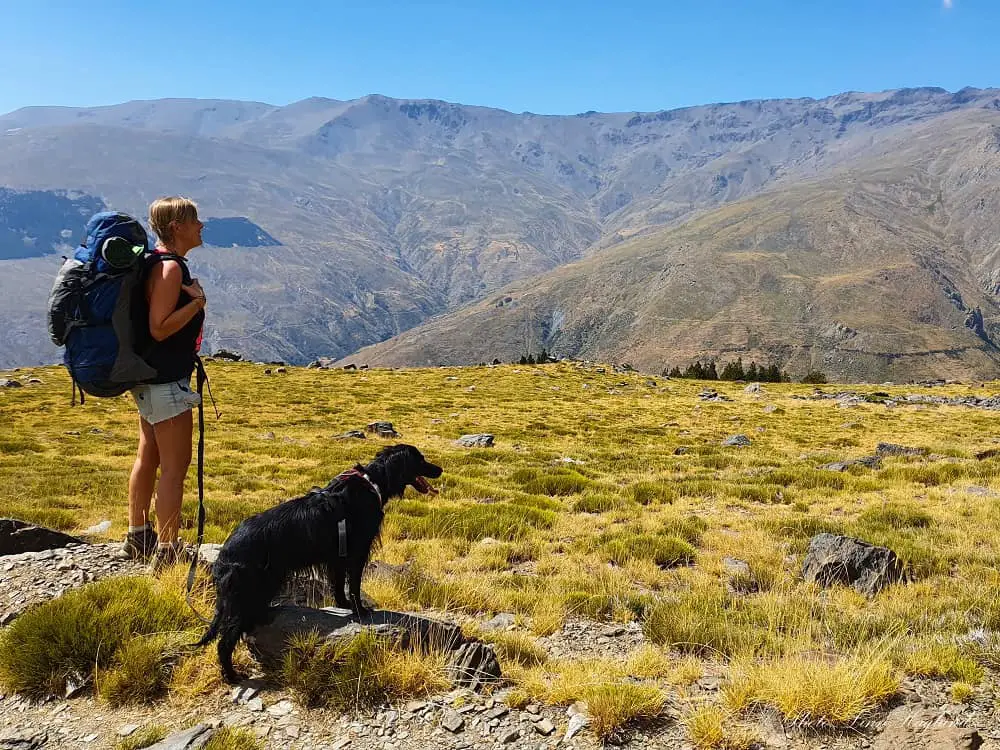
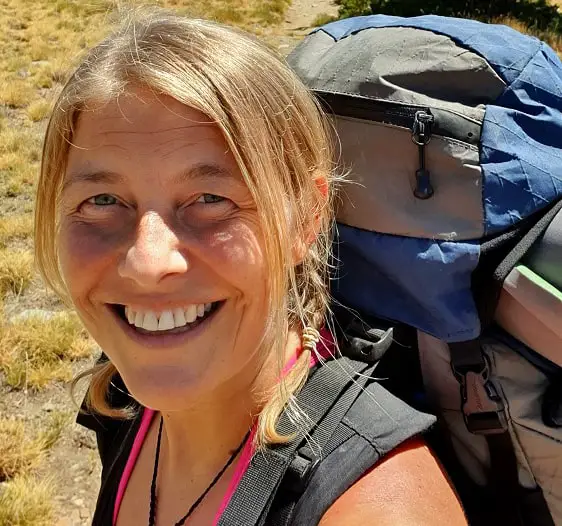
I’m Linn Haglund, the face behind Andalucia Hiking. I’m an avid hiker and after calling Andalucia home for over 10 years, I’ve covered my share of peaks, ravines, rivers, and valleys across all 8 provinces. I’m here to help you navigate this incredible region with thorough hiking guides, hiking tips, and gear recommendations.
RELATED: Best hiking gear for dogs
Table of Contents
The most common pitfalls when hiking with dogs
Before we get into the pitfalls when you hike with your dog, the most important thing to check upfront is that it’s actually allowed to bring dogs where you intent to hike.
Especially national parks and natural parks can have protected areas or hiking trails where it’s not allowed to bring dogs or where it’s mandatory to keep them on a leash at all times.
This is essential to check up in advance.
Make sure you avoid any of the following mishaps. Trust me when I say it can f*** up your day out (or other’s!)
- Not bringing enough water on trails with no natural water sources
- Forget a portable water bowl
- Forget to bring a harness or a leash
- Leave the dog unattended – and OBS! It ran after wildlife or other hikers
- Leave the dog poop in the middle of the trail for others to step on
Most of these are common sense and part of the 7 Leave No Trace Principles. But we all forget things (at least I do!) and stuff happens. That’s why it’s so important to be prepared and keep these things top of mind.

Top tips for hiking with a dog
While we’ve looked at the most common dog hiking mishaps, let’s have a look at the top tips for hiking with a dog.
As mentioned before, I’ve hiked with dogs for a long time. My last dog, Ayla – who died at 12 years old, hiked with me since she was so tiny she could barely keep up with me. Soon enough, I could barely keep up with her.
My current fur baby Atlas hiked for 4 days to the 3 highest peaks in Sierra Nevada National Park when he turned one and we couldn’t believe how he recharged his batteries every night and still had plenty of energy left when we reached the van on the evening of day four.
Hiking with my dogs has taught me a number of lessons and I’ve also had a few disappointing walks throughout the years because I forgot something important.
So I hope that these tips will help you so that you don’t have to do the same mistakes.
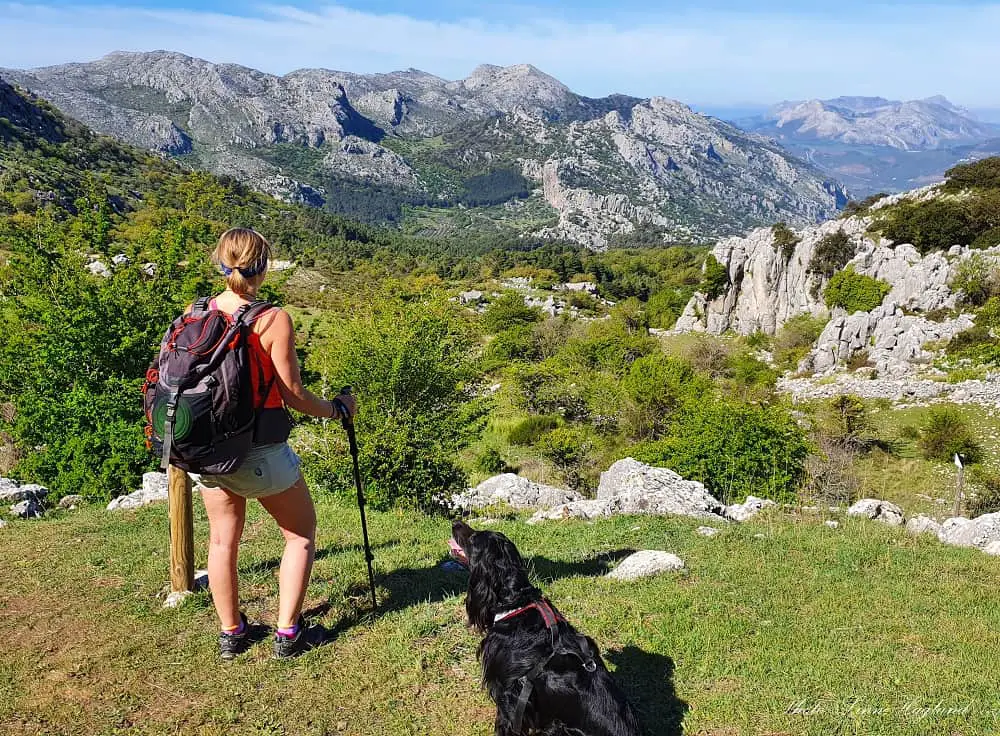
Check if there are any natural water sources along the hike
This might be one of the most important things to consider when hiking with your dog and goes hand in hand with the next point on the list.
Are you hiking where there are rivers and waterfalls along the trail? If so, you can be safe that your dog will have water to drink on the hike. But you should also ask yourself how long you need to walk in between water sources.
A good example is the Sendero de Las Cascadas in Tolox (Sierra de Las Nieves.) Half the hike goes past waterfalls and rivers. The other half doesn’t have a drop of water. That’s 5 kilometers and nearly 500 meters of elevation gain before the first drop of water for your dog. On a hot day, walking mostly under the scorching sun, this is way too long for your dog to be without water.
I learned that the hard way. Because I had to share the little water I had left (it was the second hike of the day) with Ayla before we found water.
Usually, I bring a little extra water for her even though I know there will be water on the trail, as well as a bottle that I leave in the car for both of us in case we run out on the way back.
The Greens Steel water bottles are great for this as they keep water cold for up to 48 hours – even in a scorching hot car.

Bring enough water
To continue with the importance of water for your dog, the consequences of not giving enough water to your dog during a hike, especially when hiking on hot days, can be heat stroke. You definitely don’t want that to happen.
While your dog can survive a long time without drinking, the hot sun can cause exhaustion. If you notice that your dog is hot, it might not be enough to give it water to drink, but you should pour some over it too, to cool down the body. Just like you would pour water on your own head and neck on a hot day to cool down.
This is why I can’t stress enough just how important it is to bring enough water! It’s better to take 2 liters of water with you back because you didn’t need it than walking for hours in the heat without water for you or your dog. I’ve done both.
I recommend bringing a collapsible water bowl that you can easily put in a small pocket in your hiking backpack.
For yourself, you can use a water bladder, which is what I find is the most comfortable to carry in the backpack, and then a bottle or two for your dog. You can also pour water from the water bladder into your dog’s bowl when the water bottles are empty.
And as mentioned before, always have an extra water bottle for when you get back to the car. Then you know there is something cold for you both when you get back even if you end up rationing the water the last kilometers.
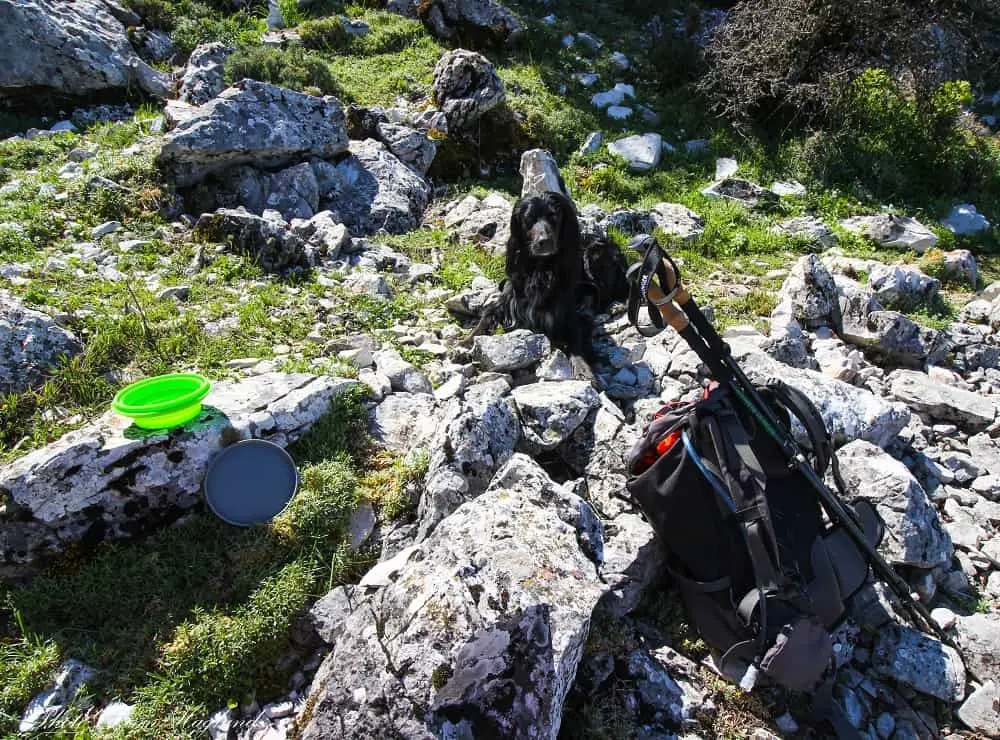
Take into consideration how fit your dog is
Not only do humans get fitter the more they are in activity. Dogs too get fitter the more they move. So while you can get exhausted heading out on a long heavy hike after no training for months, your dog will probably feel the same.
So start out slowly and build both of you up for that multiday trek with your dog. You’ll both appreciate it. Remember, dogs will usually not show you that they’re tired while they’re out walking. So it’s your job to see the signs and not push it.
You should also consider the age of your dog. A puppy will need months before it can go on longer hikes. I still remember Ayla’s first day hike. She was 4 months old and we hiked for 4-5 hours in the mountain. She collapsed under the sofa once we got home and didn’t move a limb until the morning after. I had pushed her too much.
But even your lifelong hiking buddy will get older at one point and you need to keep an eye out on your dog to pick up on when it’s time to take shorter hikes.
Look out for any changes in behavior and make sure you respect them so you don’t exhaust your bestie. Your dog will do anything for you, so it’s very likely to push its boundaries to please you too.
Check the weather forecast
If temperatures are going to be very high the day of the hike, you need to assure that there are enough water sources for the dog during the hike.
As I’ve said before, it’s not enough to have water to drink, your pet will need to have a bath in refreshing water to cool down too. This will not be an issue if it’s raining on your hike.
While it’s common knowledge that people can get heatstroke, this is also something that can happen to your dog if it doesn’t get dehydrated and cooled down on a hot day.
Especially in hot summer temperatures like you can get in Andalucia and the rest of southern Europe throughout the months of June to September.
If you’re hiking with dogs in winter, on the other hand, you’ll need to consider if it’s too cold for your dog. I’ve taken Ayla out cross country skiing at minus 20 degrees Celsius. I only managed to keep warm for 30 minutes (with good layers of wool) before I had to turn around and get into the car.
Looking back, I’m not so sure it was a good call to take her with me without a good set of paw shoes.

Check if there are any dangers for dogs where you’re going
Depending on the country you’re going hiking, there might be different dangers to dogs that you need to be aware of. Make sure you check up on this before you go and find out what to do if your dog comes in contact with it.
Examples can be scorpions, processionary caterpillars, snakes, etc. some of which you might be able to prevent a fatal encounter with if you get drugs from your vet. In other cases not.
Nonetheless, you should always be aware of what lurks around where you take your dog so you can look out for symptoms and know when to head straight back for the vet.
But there are also bigger dangers like bears, moose, and wild boar. These are animals you simply don’t want running after your dog. So make sure you’re aware of where you might find them and never leave your furry friend out of sight so you can keep it safe if you see wildlife.
Are there sections where you’ll have to carry your dog?
This is quite an essential point and so easy to forget. If there are any scrambles or sections where you have to jump or slide down rocks, you might need to carry your dog. If you hike solo, it’s important that you consider if you can handle that without help.
I, for instance, could handle carrying Ayla, as she’s only around 18 kilos, but if I need to make a jump with her in my arms, I can forget it. She’s too big for that, and I got vertigo.
However, if I can hand her over to another person, I’d mostly be fine. So know your boundaries. Because once you start to get worried and stressed, your dog will feel it and get stressed too.
A good tip is to have a good hiking harness for your dog with a good handle so you can carry it without risking your pet sliding out of it.
You can find a great quality hiking harness from RUFFWEAR here that’s ideal for those scrambles where you need to assist or lift your dog.
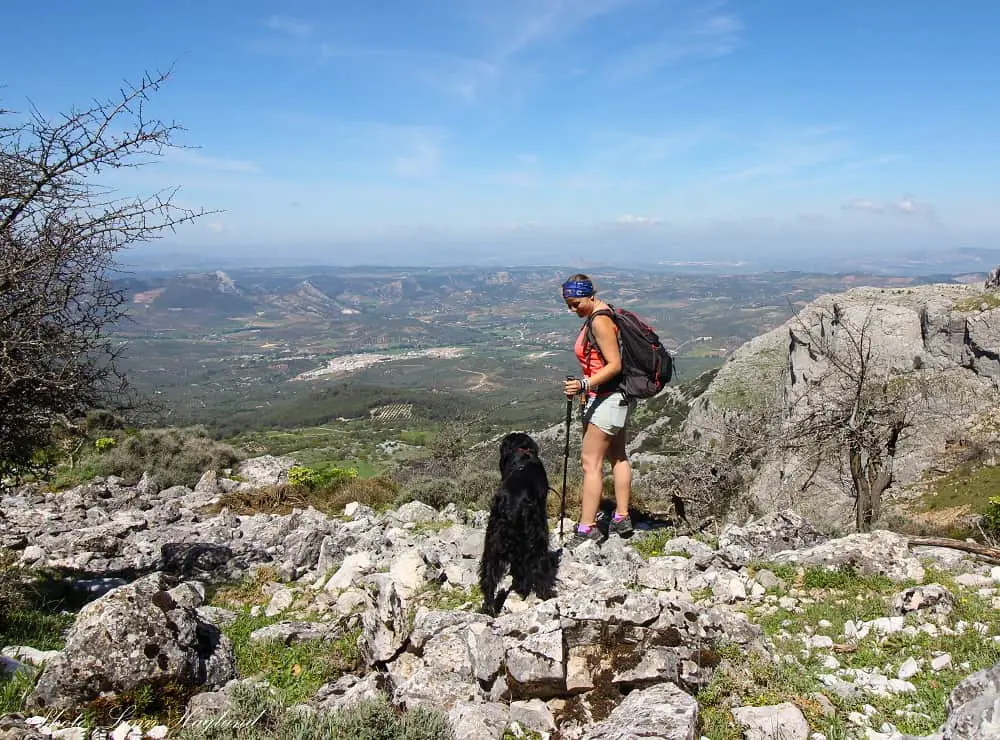
Protect your dog for ticks and other bugs
Some areas, especially in spring and summer, are crowded with little bugs that will devour your dog as soon as they see them. They live in plants and trees and when your dog walks by, they’ll fall onto them and find their way through the fur to suck onto their skin.
Ticks, fleas, lice, and other bugs are so common, and luckily there are a lot of different options to give your dog to avoid these blood-sucking little creatures to feed on your pet.
Ask your vet for something or buy from Amazon. Ayla used to get drops in her neck when we lived in Norway, as the season was short.
But here in Spain, she can get attacked all year round, so she gets a pill every three months to keep her protected at all times. For us, it’s important, as we’re constantly out hiking.
Finally, if your dog does get ticks, make sure you always carry a tick remover. It’s gross but necessary. The sooner you get it out, the better. You can get one here.
Hike with dogs responsibly
I already mentioned the importance of leaving no trace, and here are some quick tips for hiking with dogs responsibly. This includes respecting wildlife and other hikers on the trail. That’s why I dedicated this section to how to hike with your dog while leaving no trace.
Remove dog poop from the trail
Needless to say, who likes to walk on a trail full of dog poop?
Make sure you always pick up after your dog. In some areas, especially national parks and natural parks, it’s not enough to move it out of the trail and cover it up.
Dog poop is much like human poop these days. The chemicals they get in their food don’t belong in nature and can set the whole ecosystem out of balance.
There are luckily a whole lot of brands making biodegradable poop bags these days. You can stock up here.
Keep your dog close when you see other hikers or dogs on the trail
This might come as a surprise to you, but not all people like dogs. Yes, I know! I don’t get it either. But truth is, that you’re the one responsible for your dog on the trail and when you see other people, you need to make sure they want to meet your dog before you let it galop over and maybe even jump all over them with joy.
The same goes for meeting other dogs. You never know if the other dogs are as friendly or trained as your dog. So make sure you always communicate with the other dog’s owner to clarify if it’s okay for them to meet or not.
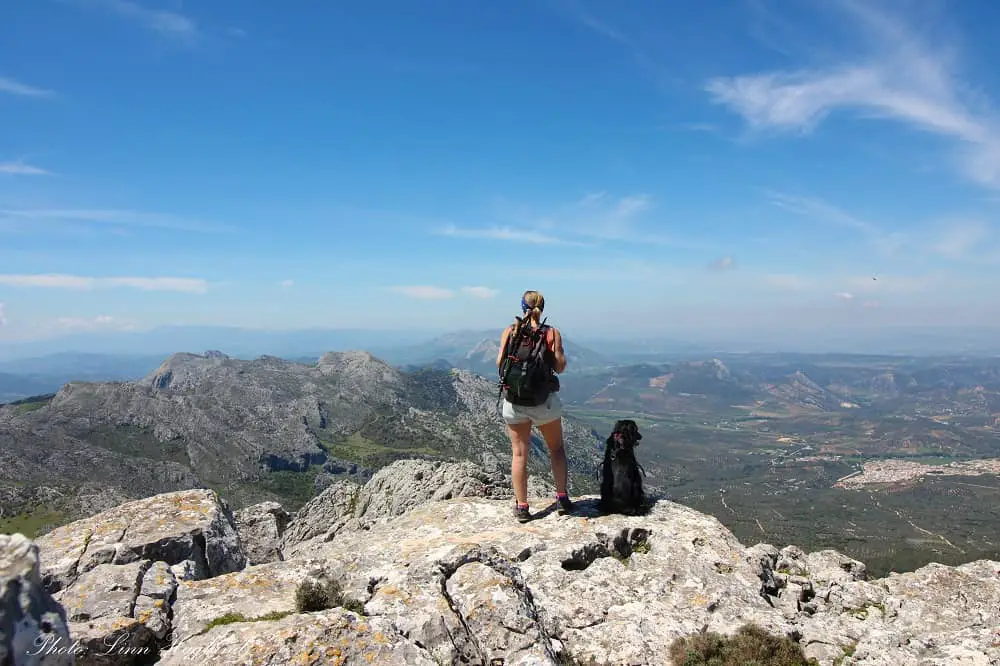
If you can’t control your dog, keep it on a leash. Always.
As you’ve already learned, not all humans are in love with dogs. I know, I don’t get it either. But it’s so important to remember that you’re in charge of your dog. And you’re responsible for its actions.
This means that even if it’s allowed to leave your dog without a leash, if you can’t control it at all times from jumping on people, getting aggressive at other dogs, or running after wildlife, you need to keep it on a leash at all times. This is your responsibility and no others.

Always keep your dog on a leash during wildlife mating seasons
Mothers are known to be very protective of their babies. This goes for wildlife too. And you don’t want your fur baby to accidentally come between a mother and a baby of any species in the wild. So keep it on a leash.
Always keep your dog on a leash if it’s mandatory
If there are rules that say your dog has to be on a leash, keep it on a leash. This is common in national parks, natural parks, and reserves. But also on trails going through farmland where sheep, goats, or cows roam around.
There’s no need to question why the rules are set, just follow them.
I’ve just given you three reasons to keep your dog on a leash. And luckily, there are ways to make it more comfortable for both you and your pup. I use a hands-free leash that I wrap around my waist. The leash itself has stretch so that it absorbs the shock of sudden tugs.
A great feature is one that doesn’t have a stretch on the last bit so that you easily can get control of your dog if you need to pull it close to you for any reason. Check out this on Amazon.
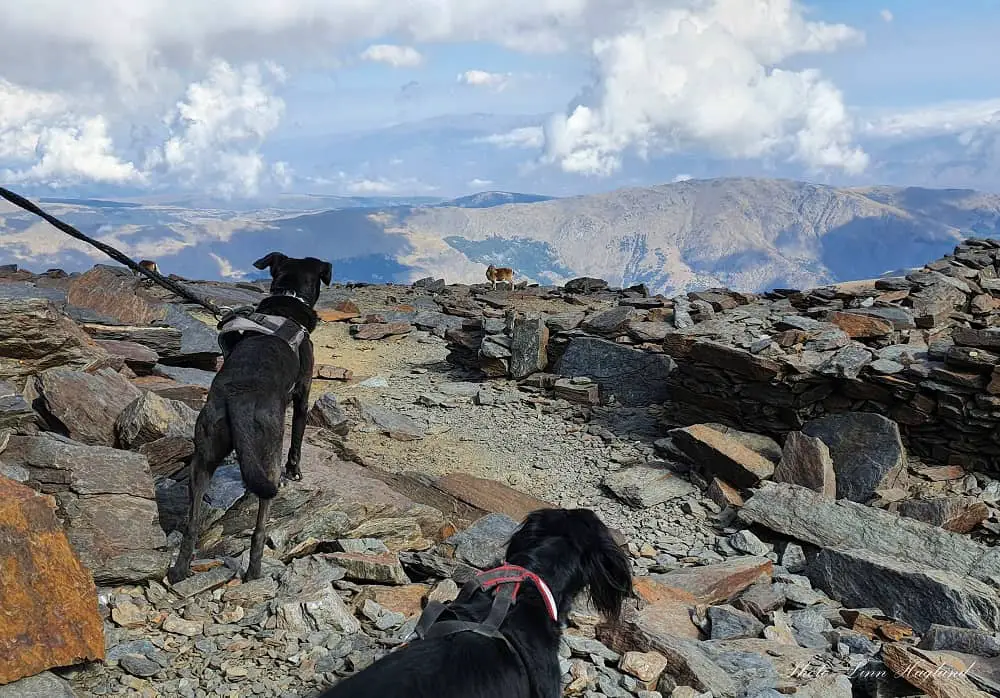
Reflections on dog hiking
With the above in mind, taking your dog hiking will be one of the best experiences you’ll have and you’ll create so many amazing memories together.
It doesn’t matter if you’re hiking with a small dog or a big dog, trekking with dogs is so rewarding. You’ll be amazed at how much a small dog can handle. It might run a few thousand steps extra, but it’ll be just as happy to share the adventure with you.
Especially if you go hiking solo, it can feel safe to have a dog with you on the trail. I definitely feel more comfortable when Ayla is with me.
If you’re new to hiking, make sure you read my top tips for first time hikers too.
Pin it for later!
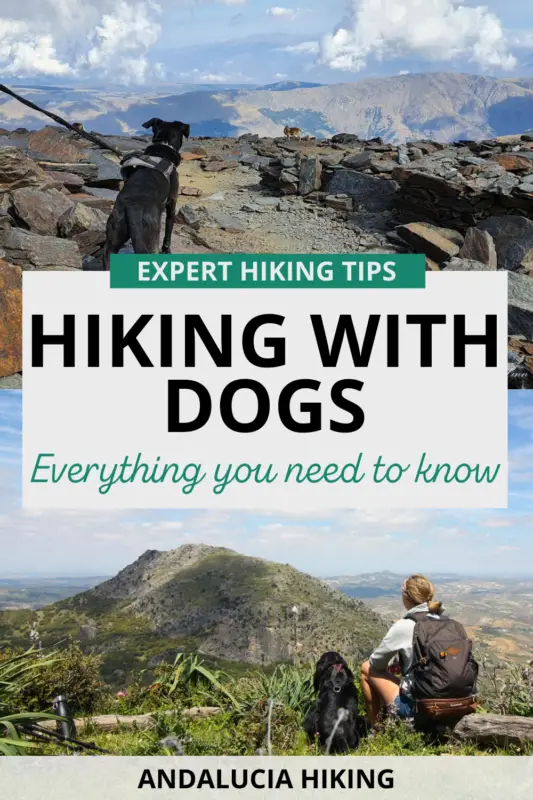


Hello! Great posts. I’m considering spending next winter in southern Spain and Portugal with my 2 dogs. Are there plenty of hikes that allow dogs to be off-leash? If you’re not in a park or around farm animals, is it generally accepted to allow a well-behaved dog to be off-leash? Thanks for any info you can give me!
To be honest with you, I never see people keeping their dogs on leash even in the national parks. I mostly keep Ayla loose, but take her on a leash in the national park and if there are livestock around. Basically, keep your dog controlled and assess when it is best to put them in a leash. In Sierra Nevada National Park I was once told by rangers to put her in a leash. I had her loos as I could see for hundreds of meters in all directions that there weren’t any mountain goats around and would have called her back if I saw anything. In Portugal, I never had any experiences where I had to keep her on leash other than my vertigo on the cliffs lol